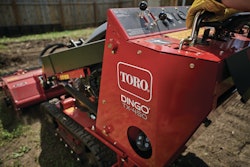
Disposing of your used machine at the right time – and getting the best price for it – requires balancing several factors.
Equipment World sat down with Logan Mellott, vice president of commercial operations for Ritchie Bros., and Doug Rusch, managing director of Ritchie’s Rouse Sales division, to discuss what goes into determining a machine’s resale value.
“There are a handful of inputs that are critical to the resale value of a used machine,” Rusch says. “First and foremost is the make and model.” Different manufacturers sell at different price points; even different machine types made by an OEM can generate different levels of buyer interest.
Four other data points go into this initial mix:
- Age, which is basically a proxy for the model year of the machine. Older machines typically sell for less.
- Machine configuration, including hydraulics, attachments, track type, etc.
- Meter reading.
- The location where the machine is sold and bought. Different geographies perform differently in the used equipment market. “It’s important to think about where you’re sitting and where the machine is sitting because location affects value,” Rusch says.
“That’s where the used equipment professionals come in and add value,” Rusch comments.
Machines age differently
Keep in mind that one hour of use does not mean the same on every type or class of equipment. “You really need to understand how a meter reading on one given machine compares to other machines in the marketplace,” Rusch says. “It’s not a one size fits all.”
Even the question about what’s more important – the hours on the machine or the year of manufacture – can be answered in different ways. “It really varies by asset type,” Mellott says.
For example, hours are critical on excavators, as is undercarriage condition and age, Mellott says. The same with dozers, although a dozer’s configuration is also key because there are more variations.
In addition, adds Rusch, different size classes within a machine type will retain value differently. As an example, an eight-year-old compact excavator might be worth around 50% of its original cost. In contrast, an eight-year-old 100,000-pound excavator would probably retain only 25-30% of its original value.
Primarily because they are used in different ways, machines have different useful lives and that directly impacts what buyers are willing to pay at certain points in a machine’s life.
For example, “compact machines have a broader secondary marketplace,” Mellott explains. Beyond construction they can go into agricultural, landscaping and hobby farm markets, to name a few.
A 100,000-pound excavator, in contrast, is primarily used in earthmoving applications and would not have the broad appeal of a compact excavator.
Timing
Timing is key whether you’re a seller or a buyer, and it plays a direct role in a machine’s value.
If it’s critical for the seller to generate cash flow, for example, that seller will most likely opt for a way that quickly puts money in his pocket, knowing he might be leaving money on the table. The same is true for buyers: if they need a machine now, they may end up paying more for it.
Sellers and buyers who can be more patient have more choices to either maximize their return or buy at a lower price. “It’s really driven by what the customer is looking to achieve overall,” Mellott says.
And as last year highlighted, markets move.
Rusch argues that a 12-month review of machine prices would include the market bottom experienced during the first months of the Covid-19 impact. “That doesn’t reflect today’s markets,” he says.
Knowledge of the now
It’s also critical to know how the markets – both overall, regionally and locally – are currently performing. Also realize that two overall markets are at play: forced liquidation value (auctions) and fair market value (retail).
Because so many variables impact values – a 2,000-hour D6 dozer sold in Dallas may be significantly different than the same make and model sold in Houston – “you need to have a strong understanding of how those markets are currently performing,” Rusch says.
To determine the current market, he notes that Rouse Sales uses a trailing 90-day database of transactions to track machine values. “We feel this is the optimal set of transactions and the one that gives you enough representation in the markets to keep you aligned with the ebbs and flows of the market,” he says.
This 90-day transactional data can also allow sellers to factor out what they expect the machine to sell for in the coming three months, Rusch says.
Ritchie's recent Orlando auction highlighted how markets can change.
Compared with Ritchie's 2020 Orlando auction, the company saw 25% more bidders on 11% fewer equipment lots. Average sale prices for most machine types were above the Rouse Services' overall forced liquidation value (FLV) index.
(Rouse Services is a division of Ritchie. The FLV on a machine is the prevailing auction sales price benchmark for an individual unit sold at auction. It only includes units with a valid make, model, and model year in the past 10-year time frame validated in the Rouse database.)
At the sale, the small-to-medium earthmoving segment -- which includes small-to-medium excavators, dozers, wheel loaders, compact track loaders, backhoes and skid steers -- was a cumulative 102.0 of the Rouse FLV. Prices for compact track loaders (at 106.1% average sale price/FLV) and wheel loaders (at 104.1%) led this sector.
Looking at the large earthmoving segment, which includes large excavators, large dozers, articulate truck, motor graders and large wheel loaders, average sales prices were a cumulative 97.9% of the Rouse FLV index at the Orlando sales. Motor graders (105.4%) and articulated trucks (103.6%) generated the highest prices.














